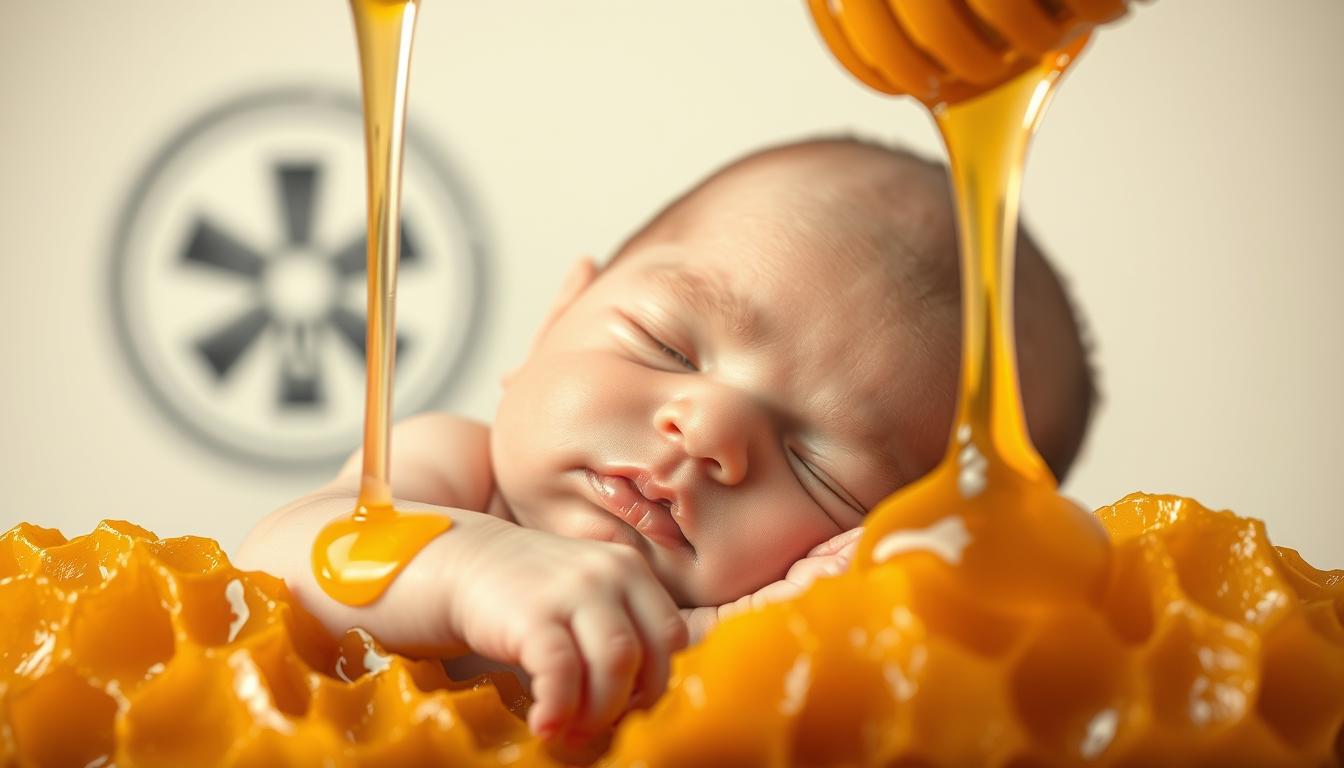why can’t babies have honey
why can’t babies have honey
Giving honey to babies may seem harmless, but it poses a significant risk to their health. The primary concern is infant botulism, a condition caused by a toxin produced by the bacteria Clostridium botulinum, which can be present in honey.
Infants under one year are particularly vulnerable because their digestive systems are still developing, and they haven’t acquired the stomach acid to kill off these harmful bacteria. Consuming honey contaminated with C. botulinum spores can lead to infant botulism, a potentially life-threatening condition.
Key Takeaways
- Honey can contain C. botulinum spores that cause infant botulism.
- Infants under one year are at the highest risk due to their underdeveloped digestive systems.
- Avoid giving honey to babies to ensure their safety.
- Infant botulism can be life-threatening if not treated promptly.
- Always check with a pediatrician before introducing new foods to your infant’s diet.
The Danger Behind the Sweetness
Honey, a seemingly harmless sweetener, poses a significant threat to infants due to the risk of botulism. This condition is caused by the bacterium Clostridium botulinum, which can be present in honey. When ingested, these spores can produce toxins in the infant’s gastrointestinal tract, leading to botulism.
Understanding the Risks at a Glance
Infant botulism is a serious condition that can cause a range of symptoms, from mild to severe. The risk is particularly high for infants under 12 months, as their digestive systems are not mature enough to handle the spores.
How Common is Infant Botulism?
Infant botulism is relatively rare, but it is a significant concern. According to the Centers for Disease Control and Prevention (CDC), there are approximately 100-200 reported cases of infant botulism annually in the United States.
Statistics in the United States
The CDC reports that the majority of infant botulism cases occur in infants under 6 months. The exact number of cases can vary from year to year, but vigilance is always necessary.
Global Occurrence Rates
Globally, the incidence of infant botulism varies. However, it is recognized as a significant health risk in many countries, prompting health organizations to issue guidelines on the safe consumption of honey by infants.
As Dr. Jane Smith, a pediatrician, notes, “The risk of botulism is a critical concern for parents. Avoiding honey until the infant is at least 12 months old is a simple yet effective precaution.”
Why Can’t Babies Have Honey: The Medical Explanation
The medical explanation behind the warning against feeding honey to babies lies in the risk of botulism, a potentially life-threatening illness. Botulism is caused by the toxin produced by the bacteria Clostridium botulinum. This toxin can lead to severe health issues, including muscle weakness, paralysis, and breathing difficulties.
The Connection Between Honey and Botulism
Honey can be a source of Clostridium botulinum spores. These spores are generally harmless to adults and older children because their digestive systems can handle them. However, for infants, the story is different. Their digestive systems are still developing, and they lack the stomach acid to kill off these spores.
Age-Related Vulnerability
Babies under 12 months are particularly vulnerable to infant botulism due to their immature immune systems and developing gut flora.
Immature Immune Systems
Infants have immune systems that are still learning to fight off pathogens. This makes them more susceptible to infections, including those caused by Clostridium botulinum spores. As Dr. Sarah S. Long, a pediatrician, notes, “Infant botulism is a serious condition that requires prompt medical attention.”
“The gut of an infant is not as mature as that of an adult, making it easier for the spores to germinate and produce toxin.”
Developing Gut Flora
The gut flora of infants is still in the process of development. A healthy gut microbiome is crucial for overall health, and in infants, it’s still being established. The absence of a mature gut flora makes it easier for harmful bacteria to take hold.
To summarize, the key factors that make babies vulnerable to botulism from honey consumption are:
- Immature immune systems that can’t effectively fight off pathogens
- Developing gut flora that hasn’t yet established a healthy balance of bacteria
Understanding these factors is crucial for parents and caregivers to make informed decisions about introducing honey or honey-containing products into a baby’s diet.
The Science Behind Infant Botulism
Understanding the science behind infant botulism requires a look into the bacteria Clostridium botulinum and its spores. This bacterium is the source of the toxin that causes botulism, a potentially life-threatening condition.
Clostridium Botulinum Spores Explained
Clostridium botulinum spores are ubiquitous in the environment, found in soil, water, and the gastrointestinal tracts of animals. These spores are highly resistant to environmental stress and can survive in a variety of conditions.
How Spores Survive in Honey
Honey can contain Clostridium botulinum spores because bees can pick up these spores from the environment. The spores can then be deposited into honey, where they remain dormant until ingested.
The Toxin Production Process
The production of the botulinum toxin occurs when the spores germinate in the infant’s gastrointestinal tract. The toxin is produced as the bacteria grow and multiply.
From Spore to Neurotoxin
The process from spore to neurotoxin involves several steps, starting with the germination of the spore, followed by the growth of the bacteria, and culminating in the production of the toxin.
Effects on the Nervous System
The botulinum neurotoxin affects the nervous system by blocking the release of the neurotransmitter acetylcholine, leading to muscle weakness and paralysis.
- Clostridium botulinum spores are highly resistant and can be found in honey.
- The spores can germinate in an infant’s digestive system, producing a toxin.
- The toxin affects the nervous system, causing muscle weakness and paralysis.
Recognizing Symptoms of Honey-Related Botulism
Understanding the early warning signs of honey-related botulism can be lifesaving for infants. Botulism is a serious condition caused by a toxin produced by the bacteria Clostridium botulinum, which can be present in honey. When infants ingest this honey, they can develop botulism, leading to severe health complications.
Early Warning Signs
The initial symptoms of infant botulism can be subtle but recognizing them early is crucial. Some of the early warning signs include:
- Constipation
- Feeding difficulties
- Muscle weakness
- Lethargy
Constipation and Feeding Difficulties
One of the first signs of botulism in infants is constipation, which can be followed by feeding difficulties. Infants may show less interest in feeding or have trouble sucking and swallowing.
Muscle Weakness and Lethargy
As the toxin progresses, infants may exhibit muscle weakness and lethargy, appearing floppy or less responsive than usual. These symptoms require immediate medical attention.
Progression of Symptoms
If left untreated, the symptoms of botulism can progress, leading to more severe health issues, including respiratory failure. It’s essential to monitor infants closely for any signs of botulism and seek medical help promptly.
When to Seek Emergency Care
If you suspect your infant is showing symptoms of botulism, it’s crucial to seek emergency care immediately. Delaying treatment can lead to serious complications. Early intervention is key to managing botulism effectively.
In conclusion, being aware of the symptoms of honey-related botulism and understanding when to seek emergency care can significantly impact the health and well-being of your infant. Always consult with a healthcare professional if you have any concerns about your baby’s health.
Treatment Options for Infant Botulism
The treatment of infant botulism involves a combination of medical interventions and supportive care. Prompt treatment is essential to reduce the risk of complications and improve outcomes.
Medical Interventions
One of the primary medical interventions for infant botulism is the administration of Botulism Immune Globulin (BIG-IV). This treatment has been shown to significantly reduce the severity and duration of the illness.
Botulism Immune Globulin (BIG-IV)
BIG-IV is a specially designed antitoxin that neutralizes the botulinum toxin. It is derived from human plasma and is specifically indicated for the treatment of infant botulism.
Supportive Care Measures
In addition to BIG-IV, supportive care measures play a crucial role in managing infant botulism. These may include:
- Monitoring of respiratory function
- Nutritional support
- Physical therapy to prevent muscle atrophy
Recovery Timeline and Expectations
The recovery timeline for infant botulism can vary depending on the severity of the condition and the promptness of treatment. Generally, with appropriate care, most infants begin to show improvement within a few weeks.
Long-term Outcomes
With modern treatment, the majority of infants recover fully from botulism. However, some may experience lingering effects such as weakness or fatigue. Long-term follow-up care is essential to monitor for any potential sequelae.
| Treatment Aspect | Description | Benefits |
|---|---|---|
| Botulism Immune Globulin (BIG-IV) | Antitoxin derived from human plasma | Reduces severity and duration of illness |
| Supportive Care | Includes respiratory monitoring, nutritional support, and physical therapy | Manages symptoms and prevents complications |
| Recovery Timeline | Varies depending on condition severity and treatment promptness | Most infants show improvement within weeks |
When Does Honey Become Safe for Children?
Understanding when honey becomes safe for children is crucial for parents seeking to diversify their child’s diet. The introduction of honey into a child’s meals is a significant decision that depends on several factors, primarily the child’s age and digestive system development.
The Critical 12-Month Threshold
Children under 12 months are at risk of infant botulism if they consume honey contaminated with Clostridium botulinum spores. The American Academy of Pediatrics advises against giving honey to infants under one year old. After this critical threshold, the risk significantly decreases as the child’s digestive system matures.
Digestive System Development
By around 12 months, a child’s digestive system has developed enough to handle the spores that may be present in honey. The maturation of the digestive system is key to safely introducing honey into a child’s diet.
Introducing Honey Safely After One Year
Once a child is over one year old, honey can be introduced in small amounts. It’s essential to start with a small quantity to monitor for any signs of an allergic reaction.
Recommended Portions
Begin with a tiny amount, such as a quarter teaspoon, to test tolerance. Gradually increase the amount if no adverse reactions occur.
Monitoring for Allergic Reactions
Watch for symptoms such as rash, itching, swelling, or digestive issues. If any of these symptoms appear, consult a healthcare provider for advice.

Introducing honey to children after they turn one year old can be done safely by following these guidelines. Always prioritize caution and consult with a healthcare professional if you have any concerns.
Hidden Sources of Honey to Avoid
Understanding where honey is hidden in foods is a critical step for parents in preventing infant botulism. Honey is not just a standalone food; it’s also an ingredient in many processed and baked goods.
Processed Foods and Baked Goods
Honey is often used as a sweetener in various processed foods and baked goods. Common products that may contain honey include:
- Cereals
- Bread
- Granola bars
- Baked goods like muffins and cakes
Always check the ingredient list to identify if honey is present.
Reading Food Labels Effectively
To avoid honey, parents must become adept at reading food labels. Look for honey under various names, such as:
- Honey
- Bee honey
- Pure honey
Restaurant and Homemade Foods
When dining out or preparing homemade foods, it’s crucial to be aware of the ingredients used. Ask questions when you’re unsure.
Questions to Ask When Dining Out
When at a restaurant, ask your server:
- Does the dish contain honey?
- Are there any honey-based ingredients in the recipe?
Communicating with Caregivers and Family
Ensure that caregivers and family members are also aware of the risks. Communicate clearly about the importance of avoiding honey for infants.
Conclusion: Protecting Your Baby While Following Expert Guidelines
As a parent, ensuring your baby’s safety is paramount. When it comes to honey, understanding the risks and following expert guidelines is crucial for protecting your baby from infant botulism.
By now, you’re aware that honey can contain Clostridium botulinum spores, which can produce a toxin harmful to infants under 12 months. The American Academy of Pediatrics recommends avoiding honey for babies until they reach this critical age milestone.
To keep your baby safe, be mindful of hidden sources of honey in processed foods and baked goods, and always read food labels effectively. When introducing honey after one year, do so safely by following proper guidelines.
By adhering to expert guidelines on honey safety and being vigilant about your baby’s diet, you can significantly reduce the risk of infant botulism. Protecting your baby involves making informed decisions, and with the right knowledge, you can ensure a healthy start in life.
FAQ
What is infant botulism?
Infant botulism is a rare but serious illness caused by a toxin produced by the bacteria Clostridium botulinum. It occurs when an infant ingests spores of the bacteria, which then grow and produce the toxin in their intestines.
Can babies under one year have honey?
No, babies under one year should not be given honey because it can contain spores of Clostridium botulinum, which can cause infant botulism.
What are the symptoms of infant botulism?
Symptoms of infant botulism can include constipation, feeding difficulties, muscle weakness, lethargy, and a weak cry. If you suspect your baby is showing these symptoms, seek medical attention immediately.
How is infant botulism treated?
Infant botulism is treated with Botulism Immune Globulin (BIG-IV) and supportive care measures, such as hospitalization and respiratory support, to manage symptoms and prevent complications.
At what age can I introduce honey to my child?
It is generally recommended to wait until a child is at least 12 months old before introducing honey into their diet, as their digestive system is more mature and less susceptible to the risks associated with Clostridium botulinum spores.
Are there hidden sources of honey that I should be aware of?
Yes, honey can be hidden in various foods, such as baked goods, cereals, and processed snacks. Always read food labels carefully to check for honey or other ingredients that may contain Clostridium botulinum spores.
Can I give my child honey if they have a weakened immune system?
No, even after one year, if your child has a weakened immune system, you should consult with your pediatrician before giving them honey, as they may still be at risk for infant botulism.
How can I safely introduce honey to my child’s diet?
When introducing honey to your child’s diet, start with a small amount and monitor for any signs of an allergic reaction or intolerance. Also, choose a high-quality, pure honey to minimize the risk of contamination.


